Light+building 2016 LGD OLED Lighting
LG Display is showcasing its latest advanced OLED light products and solutions at Light+Building 2016
LG Display is showcasing its latest advanced OLED light products and solutions at Light+Building 2016
Sumitomo Chemical will exhibit its polymer OLED lighting at “Light+Building 2016,” one of the world’s largest trade fairs for lighting and building technology, to be held in Frankfurt, Germany, from March 13 to March 18, 2016.
This is the third time for Sumitomo Chemical to exhibit its products at the trade fair, following its previous participation in 2014. Sumitomo Chemical will run a booth at the trade fair, inviting the world-renowned Japanese lighting designer Motoko Ishii as the art director for the exhibit.
Sumitomo Chemical’s exhibit, named “OLED JARDIN,” symbolises a “Garden in the Sky” as formed from polymer OLED lighting panels, creating an approachable space of a vast expanse with a taste of Japanese grace added.
In addition to “OLED JARDIN,” Sumitomo Chemical will exhibit its newly-designed OLED panels, improved for brightness and luminance efficiency from those displayed in the previous trade fair. The new polymer OLED panels, available in a range of colors, shapes and sizes, provide a greater degree of flexibility in the design for various spaces and applications.
Following the exhibit at “Light+Building 2016,” Sumitomo Chemical will start the sales of its new product line-up consisting of polymer OLED lighting panels in April this year, aiming to further expand its OLED lighting business.
Innovation Center for Organic Electronics in Yamagata University in Japan discussed low cost flexible OLED encapsulation in Lighting Japan 2016 conference. Existing flexible OLED encapsulation mainly used hybrid encapsulation structure that forms multi-layer thin film passivation layers on top of OLED, and then applying adhesive organic material and laminating gas barrier film. The encapsulation structure presented by Yamagata University forms, of the hybrid encapsulation structure, thermoset resin and barrier film above OLED without multi-layer thin film passivation, and laminate at approximately 130 °C. Yamagata University announced that they were successful in transparent flexible OLED panel development on January 13 using encapsulation, and that this panel will be presented in Printable Electronics 2016 in Tokyo from January 27.
The OLED panel to be exhibited is a leaf shaped of 45 mm width, 110 mm length, weighs less than 1.2g, and 250 um thick transparent film substrate that can be folded.
According to Yamagata University, if the newly developed encapsulation is applied, the OLED lighting panel price can be reduced as passivation layer is not used. Also, Yamagata University revealed as it can satisfy both transparent and flexible categories simultaneously, it is estimated that it will become a key technology in future transparent flexible OLED lighting development.
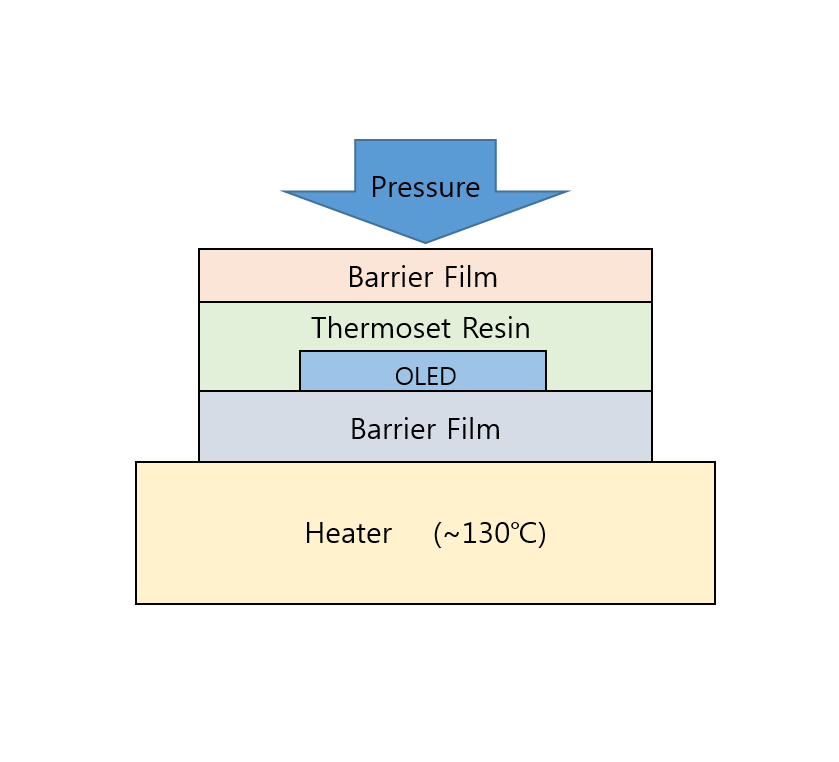
Low Cost Flexible OLED Encapsulation, Yamagata University
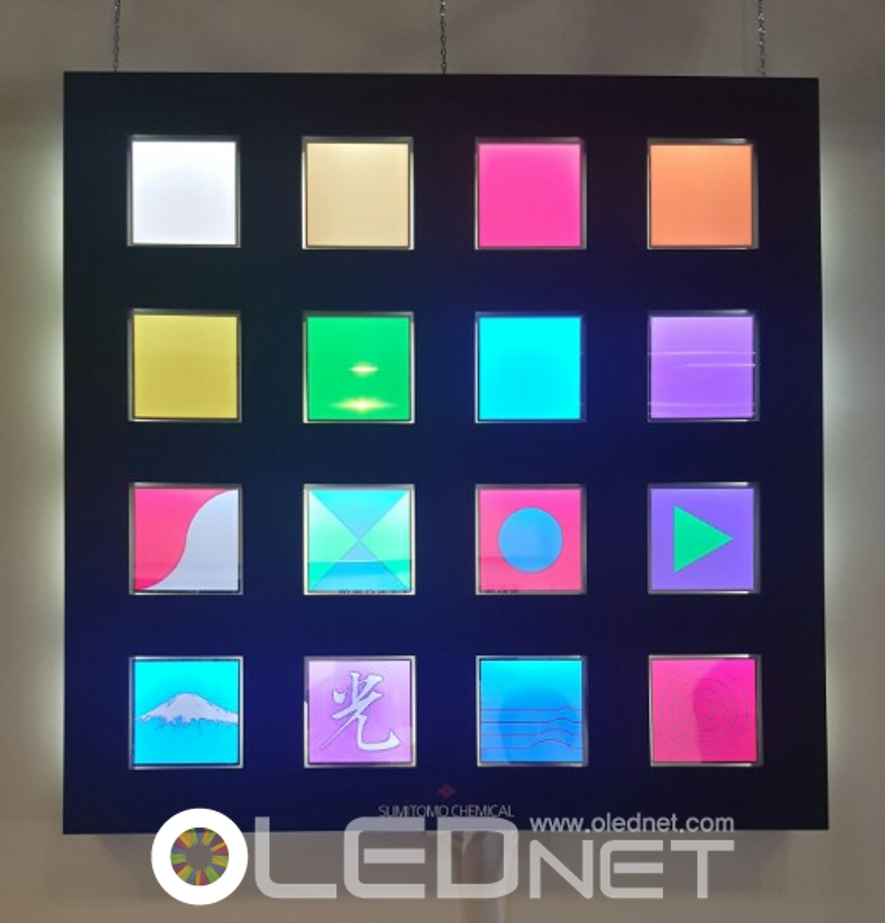
Sumitomo Chemical’s Decorative P-LED Lighting Panel, Lighting Japan 2016
Sumitomo Chemical revealed that they are planning to enter the general lighting market with solution process applied P-LED (polymer OLED).
Sumitomo Chemical is a company developing polymer and solution process applied OLED lighting panel. The company began actively selling decorative OLED lighting panel from H2 2015.
In Lighting Japan 2016 exhibition, Sumitomo Chemical announced that through their polymer materials and process technology, 80-90% of evaporation materials efficiency, and lifetime of approximately 20,000 hours at white 60-80 lm/w have been achieved. From 2017, they are planning to commercialize solution process OLED lighting panel as general lighting, as well as for decorative use, and revealed that the biggest issues are cost and improvement of consumers’ OLED awareness.
According to these issues, Sumitomo Chemical explained that although the cost of emitting area formed through solution process, cost down of evaporation formed emitting area and electrode part is required further. Although the 20,000 hours of lifetime is satisfactory, as consumers are aware that LED lighting’s lifetime is 40,000 hours or longer, Sumitomo Chemical pointed out it is important to change consumer’s OLED lighting awareness and understanding of lighting products.
by Moojong Lim, reporter@olednet.com
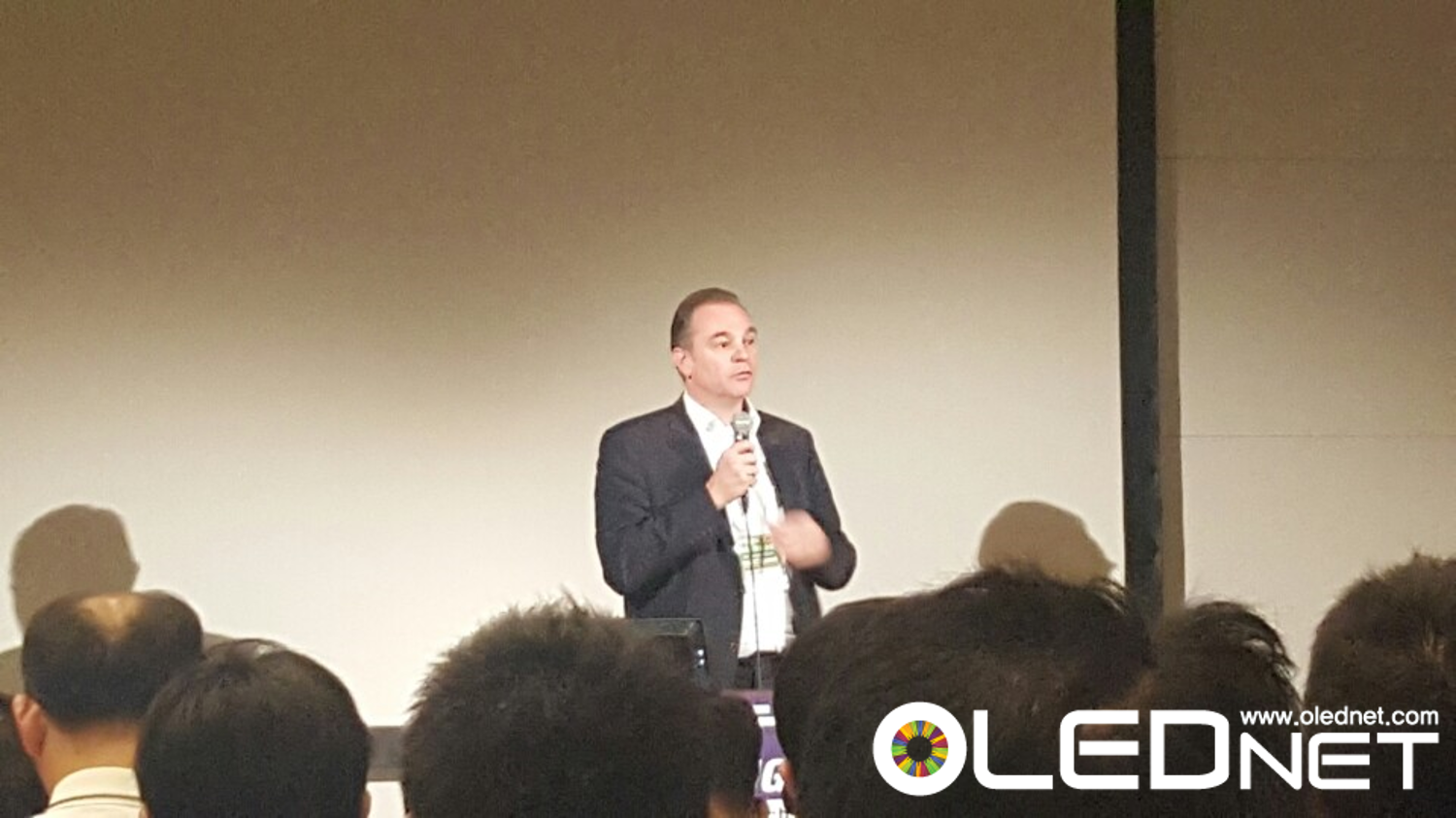
Osram Bussiness Unit Digital Systems’s CEO, Geert van der Meer, Lighting Japan 2016
In Lighting Japan 2016 Keynote Session, Geer van der Meer, CEO of Osram Business Unit Digital Systems, suggested directions for future lighting industry.
Geert van der Meer explained that the current lighting market is rapidly adopting LED, but the large volume of Chinese products is decreasing the price of LED source and device quickly. He emphasized that with the trend of disappearance of lighting companies’ profit, new business format is required to create profit.
The new businesses suggested by Osram are embedded lighting, and connected and smart lighting. He suggested lighting industry should move toward where the lighting can be used as part of building materials through internal installations and utilization as indirect illumination, and adopt smart system and form smart building and furthermore, smart city.
The current lighting market’s players are being joined by IT related companies, BMS (business management system) companies, and electronic appliances companies, and its megatrend is changing rapidly. Accordingly, Osram is expanding from the existing lighting to lighting electronics such as module and control gears, lighting solution system, and specialty lighting such as OLED and automotive. Osram also revealed that they took over a wireless energy management system company called ENCELIUM and intensifying focus on smart lighting system business.
Smart system provides many different functions such as energy reporting, remote and preventative maintenance, personal lighting control, and zone analysis among others and can optimize energy reduction, maintenance cost reduction, and workspace environment. Van der Meer emphasized that new function can be created through lighting used area’s data analysis and become the focus of future lighting analysis.
OLED TV, first released in Q4 2013, recorded approximately 50,000 units of shipment each in Q1 and 2 this year. The shipment increased to 100,000 units in Q3, more than twice the amount of each quarter in H1 2015. As it is estimated that close to 200,000 units were released in Q4, over 90% of LG Display’s 2015 target is expected to be achieved. This is considered to be showing price competitiveness against other TV as the price of OLED TV fell to 1/2 of the initial price and effectiveness of aggressive marketing emphasizing the advantages of OLED TV compared to newly released LCD TV. In Q3 earnings results announcement, LG Display revealed their plan of 1,000,000 units of OLED TV panel shipment in 2016 and forecast OLED TV’s growth. For the industry, 2015 has been the year that secured foothold for OLED TV’s market expansion.
At the time of Galaxy S6 and Galaxy S6 Edge’s release, Samsung Electronics estimated the initial supply to be 50:50. However, Galaxy S6 Edge showed 70% in actual demand and this led to shortage in supply. Samsung Display met the demand by starting flexible AMOLED line operation earlier than scheduled. 2015 proved future market growth potential by opening consumers’ wallets through designs possible only with flexible AMOLED panel.
During the Q3 earnings announcement, Samsung Display revealed their plan to expand non-Samsung clients by 30%. Accordingly, in Q3, when smartphone market’s growth was expected to slow down, the sales performance improved by 13% compared to its previous quarter through key client’s new product release and expansion of client base. Particularly, the market occupation of AMOLED panel shipped toward China is analyzed to have increased within the global mobile market as Chinese set companies released AMOLED panel equipped smartphones.
Apple, which has been using LCD panel for all products, first applied flexible AMOLED panel, produced by LG Display, to 2015 smartwatch Apple Watch and drew much attention. In H2, Apple diversified suppliers by using Samsung Display’s flexible AMOLED panel. This move is analyzed to be groundwork for flexible OLED application to smartphone following smartwatch. 2015 has been a year with much interest in when flexible AMOLED panel equipped iPhone will be released.
Global OLED lighting industry went through a great transformation in 2015. OLEDWorks announced they will acquire key parts of Philips’ OLED lighting business, relevant production facilities, and intellectual property. With this take over, OLEDWorks greatly expanded business through widened product portfolio and simultaneous lighting panel mass production in the US and Germany. LG Chem. transferred OLED lighting business to LG Display. The value of transfer is 1.6 billion KRW, and it is seen to be a strategy to increase competiveness by transferring the business to LG Display with their OLED panel mass production knowledge and to focus on existing materials business. The take over and business transfer of the main players in OLED lighting industry, OLEDWorks and LG Chem., are following their own business strategy. However, following these moves, related investment is expected to be delayed for some time and eyes are on how these will affect the OLED lighting business overall.
Numerous researches have been sounding alarm with increasing frequency on the health hazards of blue light. They report that blue light possesses potential hazard to the retina of human eyes, circadian rhythm, melatonin secretion, and cancer risk.
To devise a human-friendly light source and to also trigger a “Lighting Renaissance”, the Prof. Jou’s OLED research group from National Tsing Hua University (NTHU), Taiwan, demonstrates a high light quality and blue-hazard free candlelight OLED, that serves as a good measure and a wisely choice for general lighting. Just before Christmas, the candlelight OLED has won the International Dark-Sky Association Lighting Design Award and Domestic golden lighting medal. Moreover, Taiwan’s government highlights and entirely promotes NTHU and WiseChip Semiconductor Inc. to further investigate candlelight OLED technology via the highest Ministry of Economic Affairs support in following two years. It’s surely confirmed that the health-friendly candlelight OLED can be commercialized, accessible and affordable for human mankind by the end of 2017.
Additionally, the IDA website announced that “Since 2006, Prof. Jou has worked with students on organic LED (OLED) lighting technologies in an effort to create lighting that minimizes negative impacts to human health. In this work, he and his research team has made numerous breakthroughs, such as the creation of very low color temperature OLED, sunlight-style OLED, pseudo-natural light OLED, and candlelight-style OLED devices. Their candlelight-style OLED has attracted a considerable attention from both academia and industries. Most importantly, the candle-like OLED has also been praised by medical experts and is considered one of the safest electricity-driven lighting sources. This lighting can be used in both indoor and outdoor applications.”
Upcoming lighting industrial trends should be psychological- and physiological- friendly lighting sources. Currently, the gross production value of OLED up to 4,000 billion US dollars.
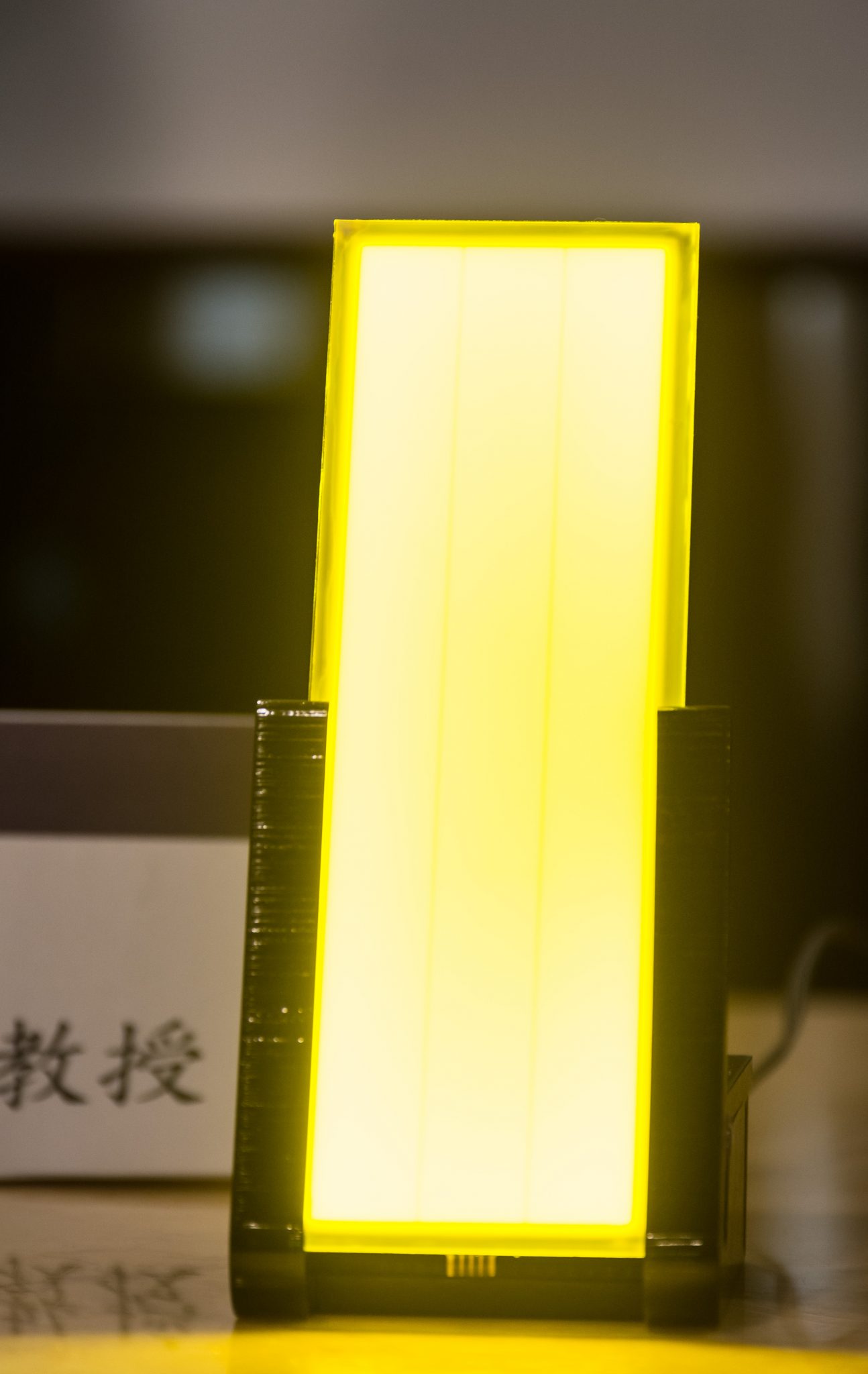
Candlelight OLED, Source: NTHU
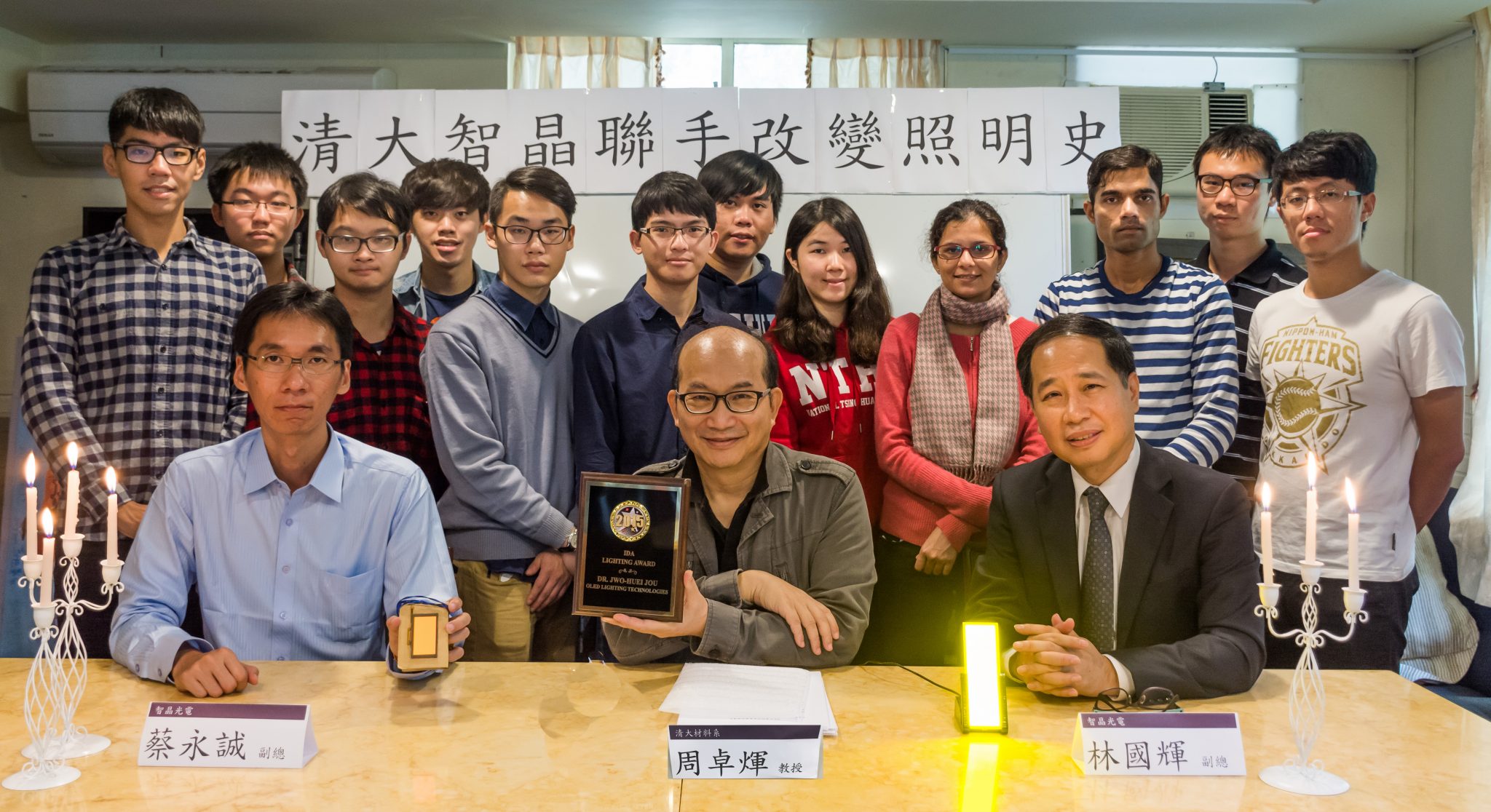
Professor Jou’s Research Team, Source: NTHU
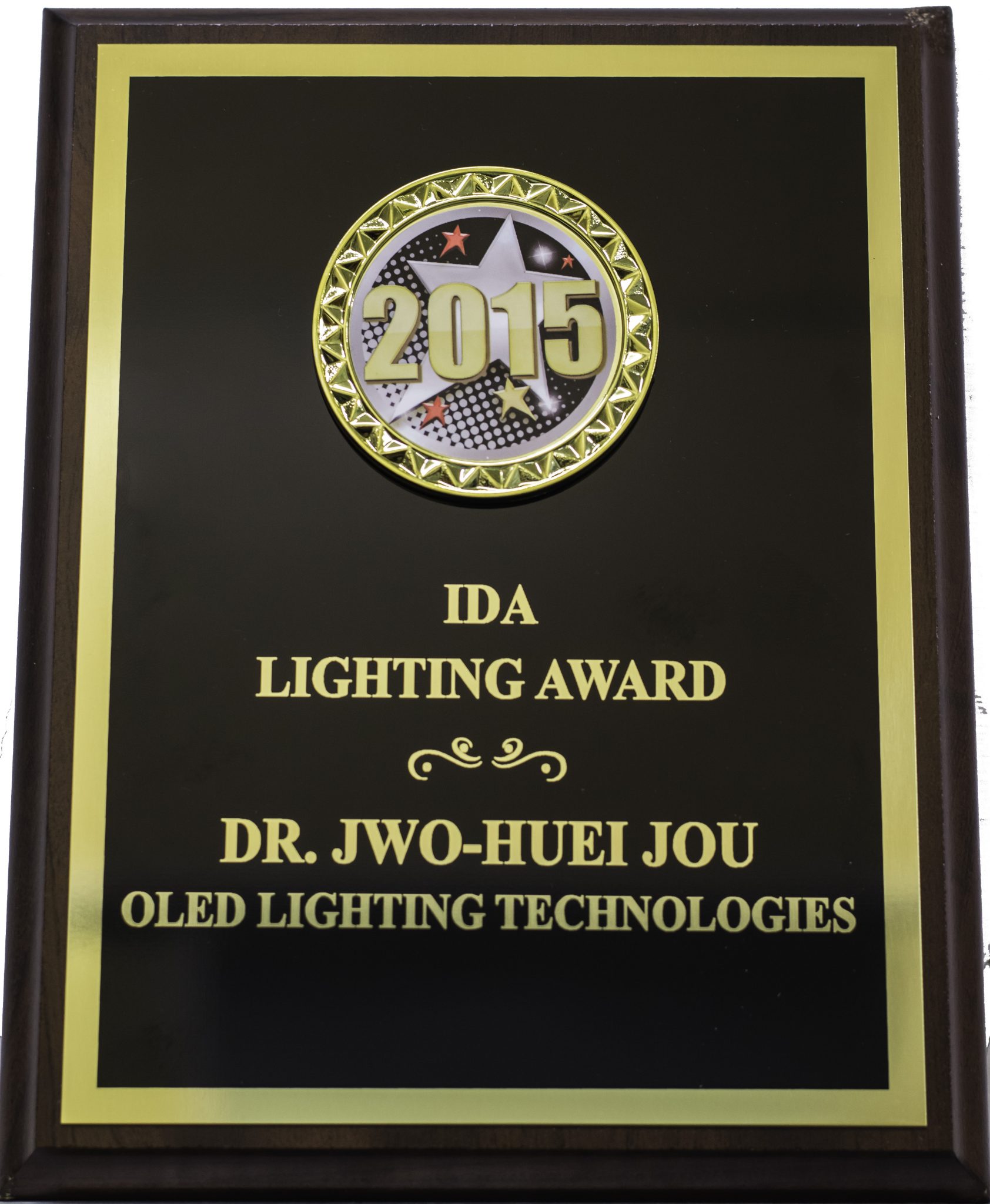
IDA Received by Professor Jou’s Research Team, Source : NTHU
At R&D Korea 2015 (November 19-21), ETRI (Electronics and Telecommunications Research Institute) revealed OLED lighting and graphene related research results.
Since 2013, ETRI has been participating in ‘Graphene Applied OLED Device/Panel Technology Development’ project as a supervising organization. This project is a part of ‘Graphene Device/Component Commercialization Technology Business’, which is a Korean national project. This project’s ultimate aims include development of graphene electrode material with ≥15Ω sheet resistance, ≥90% transmittance, 3nm thickness, ≤5% sheet resistance uniformity, ≤5nm surface profile, and ≥5.5 generation area, graphene based protection layer that can be used for 5.5 generation 55inch OLED panel with ≤10-6 g/m2 WVTR, graphene anode OLED with ≥90% external quantum efficiency compared to ITO anode OLED, and diagonally 1300mm OLED panel prototype.
In this exhibition, ETRI presented OLED lighting that used graphene as the electrode. ETRI’s Dr. Jeong-Ik Lee explained that recently interest in graphene electrode is increasing to replace ITO electrode and to apply graphene electrode, optical, electrical, and process issues have to be considered. When graphene is used as OLED electrode instead of ITO, thickness and refractive index change optically and electrically energy levels change, and these have to be considered when designing. He also emphasized that in terms of process, it has to be designed keeping in mind of before and after process of electrode procedure. Dr. Lee revealed that at present optical and electrical issues are solved while the process issues are in research stage, and they are planning to present the results of this research within this year.
Graphene, with its high resistivity, is known as next generation electrode material favorable to flexible and foldable. Dr. Lee pointed out that graphene has wider viewing angle than ITO when used as transparent electrode is another important advantage, and particularly as white light source’s spectrum cannot change according to the viewing angle, graphene is suitable for application.
Graphene is a key material with a wide arrange of applications, it is being developed in diverse areas such as OLED encapsulation as well as in electrode sector. The Ministry of Science, ICT and Future Planning of Korea estimated that domestic graphene market will record 19 billion KRW until 2025. Korea Evaluation Institute of Industrial Technology, the organization in charge of this national project, gave their target as developing 9 top technology through graphene and achieve 17 billion KRW sales. Regarding this, Dr. Lee emphasized compared to other countries, Korean investment in graphene is relatively low and that now is the time for the Korean corporations and government agencies to pay more attention higher value-added businesses.
Through an interview with OLEDNET and his presentation during the OLEDs World Summit (October 27-29), OLEDWorks’ co-founder, chairman and CEO David DeJoy discussed OLEDWorks’ vision and OLED lighting.
OLEDWorks hit the headlines in April this year when it was announced they would acquire key OLED assets and relevant intellectual property from Royal Philips whose main OLED product is Lumiblade. This acquisition was finalized earlier this month, taking this relatively small but already dynamic player within the OLED lighting industry to another level with plans that include continuing production in both Germany and the US, and expanding the product portfolio.
As the world’s first area light source, OLED lighting is naturally diffusive. As the light is uniform without flickers, the glare and eye fatigue is minimized. Although it is similar to LED in that it is a solid-state lighting, OLED produces little heat and color temperature can be easily adjusted. With its thinness of the panel and no need for extra installation space, OLED lighting can bring forth new design perspectives and applications. During his talk, DeJoy commented that OLED will bring the light closer to the user and will deliver a better light experience in diverse settings including patient rooms, recovery rooms in hospitals, retail, and museums.
Although customer response to OLED light quality is extremely positive, DeJoy acknowledged that it is facing many challenges in entering the lighting market and divided the strategy to overcome this into “the four ‘A’s”: awareness, adaptability, availability, and affordability.
The ‘awareness’ includes education about the technology and benefits, as well as confidence in the OLED lighting technology reliability. The effort to build the OLED lighting awareness includes government partnerships such as DOE Funded Gateway Projects, and NYSERDA Demonstration Projects. Designers and architects are also increasingly turning to OLED for inspiration and source material. OLED lighting’s previously mentioned advantages are closely linked to the second ‘A’, ‘adaptability’. Its thinness, lack of heat, and no need for additional installation space mean that OLED lighting can easily be integrated into fixtures and used as a building material by being directly mounted on surfaces. On the subject of ‘availability’, DeJoy emphasized that more luminaire and final products should become more available to specifiers. He added that there are many in product development but they need to get into the hands of the end user. Discussing the ‘affordability’ of OLED lighting, DeJoy used OLED panel cost scenario published by the US Department of Energy which estimates that the panel price will continue to fall to reach US$10/klm, which corresponds to approximately US$100/m2, in 2025. DeJoy added that when examining the affordability of OLED lighting, the total cost has to be considered. For example, OLED lighting does not require heat sink or extra installation cost. Also, many applications do not need very high lumen output with focused beams; “it is not all about $/klm”.
DeJoy explained that OLEDWorks long term goal is making OLED lighting adaptable and available, making it easier to change the lighting when it is broken, and be user friendly. He reported that OLEDWorks will continue to expand the product portfolio, which now includes Lumiblade, for “increased performance, additional form factors, and additional CCT options, while reducing product costs”. DeJoy also added that this is “akin to the LED evolution and consistent with the U.S. Department of Energy forecast”. With their proactive and enthusiastic approach to the OLED lighting market, the industry is watching OLEDWorks with great interest. OLEDWorks’ effect on OLED lighting market is expected to be significant.
On October 23, ETRI (Electronics and Telecommunications Research Institute) Information & Communications Core Technology Research Laboratory’s Dr. Doo-Hee Cho received IEC 1906 Award at World Standards Day ceremony. The IEC 1906 Award recognizes exceptional current achievements and it is presented by the International Electrotechnical Commission, one of the top 3 international standards organizations.
Dr. Cho has been active in IEC since his involvement in 2009. The activities include serving as the president of IEC·TC34 (lighting)’s OLED working group and establishment of IEC 62866: Organic Light Emitting Diode (OLED) panels for general lighting – Safety requirements.
Founded in 1906, IEC is one of the top 3 international standards organizations along with ISO (International Organization for Standardization) and ITU (International Telecommunication Union) with 83 member countries. IEC established IEC 1906 Award in 2004. Since then they have been selecting industry’s experts with outstanding contribution to electrotechnical standardization and IEC development and presenting the award annually. With this award for Dr. Cho, acceleration to OLED lighting’s international standardization and OLED lighting business growth are anticipated.
(株)ユビ産業リサーチ/ 取締役 イ・チュンフン / 事業者の登録番号 220-87-44660 / 通信販売業の届出番号: 江南-15333号
住所: A-1901, Samho Moolsan Bldg, 83, Nonhyeon-ro, Seocho-gu, Seoul, Republic of Korea (Zip) 06775 (株)ユビ産業リサーチ / TEL:02-577-4390 / E-MAIL:marketing@ubiresearch.com
